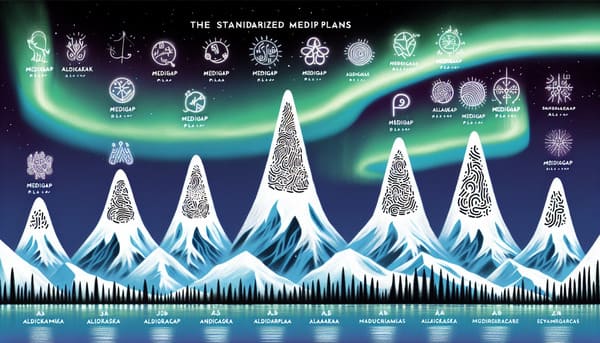
by Russell Noga | Updated April 6th, 2024
If you’re seeking to understand Medicare supplement plans in Alaska for the year 2025, you’re in the right place. With health insurance landscape shifts and new Medigap provisions on the horizon, this guide zeroes in on what you need to know about the Medicare Supplement Plans Alaska 2025 available to residents. We’ll dissect eligibility rules, financial implications, and the benefits of key plans while keeping you abreast of the latest changes and how they might impact your decision-making. Jump into a comprehensive breakdown that ensures you are well-equipped to make an informed choice about your supplemental insurance needs.
Key Takeaways
- Medicare Supplement Plans, or Medigap plans, are available in Alaska to cover out-of-pocket costs not included in Original Medicare. Ten standardized plans are available, including the favored Plans F and G.
- Eligibility for Medigap plans in Alaska varies, with individuals under 65 facing challenges in obtaining a plan until reaching 65. There is also a lack of guaranteed access to Medigap plans for those with Medicare due to disability.
- Upcoming changes to Medigap plans in Alaska for 2025 include the impact of the Inflation Reduction Act, which aims to reduce prescription costs, and state-specific regulations that may alter coverage needs and influence plan utility.
Compare 2025 Plans & Rates
Enter Zip Code
Understanding Medicare Supplement Plans in Alaska

Medicare Supplement Plans, also known as Medigap plans, hold significant importance in Alaska’s healthcare system, providing an invaluable resource to those requiring coverage beyond what Original Medicare offers. These plans are designed to offset out-of-pocket costs, such as coinsurance and deductibles, that beneficiaries would otherwise incur. In Alaska, there are ten standardized Medigap plans, each offering a distinct set of benefits. Medicare supplement insurance is regulated by both federal and state laws to ensure consistency and reliability for beneficiaries.
Out of the ten standardized plans, Alaskans predominantly favor Plans F and G. Plan G offers comprehensive coverage to all Medicare beneficiaries. At the same time, Plan F is available to those who were eligible for Medicare before January 1, 2020. Some policies also provide extended coverage for unique expenses such as excess charges and foreign travel emergencies. These plans clearly offer a broad range of options to cater to diverse health and financial needs.
The Role of Medigap Plans
Medigap plans serve as secondary insurance to Original Medicare. They are designed to cover costs such as copayments, coinsurance, and deductibles that are not covered by Medicare Parts A and B. What sets these plans apart is their standardized nature. Every Medigap plan, regardless of whether the insurance company sells it or the state in which it is sold, offers identical benefits if they bear the same letter. This standardization makes it easier for beneficiaries to compare plans and choose the one that best suits their needs.
In addition to covering out-of-pocket costs, Medigap plans can also cover expenses not included in Original Medicare coverage, such as Part B excess charges and emergency medical costs incurred during foreign travel. Beneficiaries in Alaska can enjoy the assurance of annual renewability, provided premiums continue to be paid, assuring continuous Medicare coverage over time.
Eligibility Criteria for Alaskans
The age of the Medicare beneficiary influences their eligibility for Medicare Supplement plans in Alaska. For beneficiaries under 65 years of age, purchasing a Medigap plan can be more challenging. These individuals are not entitled to an open enrollment period for these plans until they turn 65.
Moreover, Alaska does not offer guaranteed access to Medigap plans for those under 65 years old who are enrolled in Medicare due to disability. This lack of access to special enrollment periods for Medigap plans for individuals under the age of 65 underscores the challenges faced by this demographic.
Medicare Plan G 2025
Next, we will scrutinize Medicare Plan G, a highly favored Medigap plan in Alaska. For 2025, individuals with Medicare Part D prescription drug coverage will have their annual out-of-pocket costs capped at $2,000 due to provisions in the Inflation Reduction Act. This is a considerable relief for many beneficiaries who depend on multiple or high-cost prescription drugs.
Furthermore, payment policies for Medicare Advantage (MA) and Medicare Part D will experience updates in 2025 as part of the ongoing efforts to ensure stability and affordability for beneficiaries. The Centers for Medicare & Medicaid Services (CMS) are implementing technical and clinical updates, including an updated risk adjustment model, to improve payment accuracy for Medicare Advantage plans. One of the key aspects of these updates is the introduction of a new Medicare Advantage plan, which aims to enhance the benefits and affordability of Plan G for Alaskan beneficiaries in 2025.
Medicare Plan N 2025
Similar to Plan G, Medicare Plan N stands as another vital Medigap policy available in Alaska. Plan N provides a robust coverage option for beneficiaries, covering essential healthcare costs not covered by Original Medicare. While the opportunity to purchase Plan N is available to all beneficiaries over 65, the path may be more challenging for those under 65 on Medicare. These individuals often struggle to purchase Medigap policies, including Plan N, before they reach 65.
However, although Alaskan insurance companies aren’t obligated to offer all standardized Medigap plans, they must provide Plan A and either Plan C or F if they have additional plans. This rule helps ensure that beneficiaries have access to at least a basic level of supplemental coverage. For more detailed information about Plan N or other Medigap plans, Alaskans can reach out to the Medicare Information Office.
Medicare Plan F 2025
Medicare Plan F, known for its extensive coverage, is another essential Medigap policy available in Alaska. Insurance companies in Alaska must offer Plan F if they provide any plans beyond Plan A. The benefits of Plan F, like all Medigap plans in Alaska, are standardized. This means that beneficiaries can expect the same level of coverage from Plan F, regardless of the insurance company offering it.
Despite its benefits, Plan F is no longer available to new Medicare beneficiaries who became eligible after December 31, 2019. This change has led many beneficiaries to consider Plan G, which offers similar comprehensive coverage.
Regardless of the plan chosen, it’s crucial to remember that the best time to enroll in a Medigap plan is during the open enrollment period when insurance companies cannot deny coverage or charge higher premiums based on age or health conditions.
Changes in Medigap Plans for 2025

Having gained a comprehensive knowledge of Alaska’s primary Medigap plans, we will now explore the significant changes expected for these plans in 2025. These changes are driven by new regulations and plan offerings, heavily influenced by both federal reforms and state-specific regulations. Staying abreast of these changes is crucial for beneficiaries to prepare adequately and make informed decisions regarding their coverage.
To help you navigate these upcoming changes, let’s break down the impact of federal reforms and state-specific regulations.
Impact of Federal Reforms
At the federal level, reforms such as the Inflation Reduction Act will significantly impact Medigap plans in Alaska. This act will potentially reduce out-of-pocket costs for beneficiaries as Medicare gains the ability to negotiate prices for certain high-cost drugs starting in 2025.
Staying informed about such reforms will enable beneficiaries to make the most of their Medigap plans.
State-Specific Regulations
At the state level, regulations such as the expansion of the Extra Help program, the introduction of a $2,000 out-of-pocket spending cap for Medicare Part D, and changes in Medicaid coverage will influence the utility of Medigap plans in Alaska. These changes may alter the coverage needs for Alaskans with specific health conditions, such as diabetes, who rely on Medigap plans.
Understanding these state-specific regulations is crucial in selecting the best Medigap plan for your needs.
Comparing Medigap Plan Options in Alaska

Having grasped the fundamental Medigap plans and anticipated changes in 2025, the subsequent step involves comparing these plans. Beneficiaries can assess and compare Medigap policies in Alaska using online resources, including the federal Medicare website. This comparison enables residents to make informed choices regarding Medigap coverage based on their individual health needs and financial considerations.
We will now examine in detail the standardization of these plans and the functioning of premiums and cost-sharing.
Standardized Medigap Plans

In Alaska, Medigap plans are standardized, offering ten plans identified by the letters A, B, C, D, F, G, K, L, M, and N. Each of these letters represents a different level of coverage, with Plan A being the most basic. Insurance companies are required to offer at least Plan A. If they offer additional plans, they must also offer Plan C or Plan F.
The benefits of each plan are consistent across different insurance companies as long as the plan is identified by the same letter. This standardization simplifies the comparison process, enabling beneficiaries to make an apples-to-apples comparison across different providers.
Premiums and Cost-Sharing
When it comes to costs, premiums for Medigap plans in Alaska can vary based on factors such as age and gender, and the specific costs will depend on the plan chosen and the provider offering it. While the benefits of each plan are standardized, premiums can vary between providers, making it beneficial for beneficiaries to compare rates from multiple companies.
Additionally, assessing the history of a company’s premium increases is crucial, as some companies may start with lower premiums but then increase rates more steeply over time.
Compare Medicare Plans & Rates in Your Area
Enrollment Process for Medigap Plans in Alaska
After comparing your options and determining the most suitable Medigap plan, the subsequent step involves enrollment. To be eligible to purchase a Medigap policy in Alaska, beneficiaries must be enrolled in both Medicare Part A and Part B and continue to pay the monthly Medicare Part B premium alongside the Medigap premium.
The optimal time to enroll in a Medigap plan is during the Medigap open enrollment period, which is a 6-month timeframe starting when a beneficiary is 65 or older and newly enrolled in Medicare Part B. During this period, an insurer cannot deny coverage or charge higher premiums based on age or health conditions.
Open Enrollment Period
The Medigap open enrollment period in Alaska is a critical phase for Medicare beneficiaries. This period begins on the first day of the month when a beneficiary turns 65 and is enrolled in Medicare Part B, and lasts for six months. During this time, insurance companies are required to accept any applicant for any policy they provide without charging extra due to age or health conditions.
This special enrollment period offers a unique opportunity for beneficiaries to secure the essential health benefits and health insurance coverage they need without the worry of being denied or charged a higher premium due to their health status. By taking advantage of this opportunity, individuals can ensure they have the insurance coverage necessary for their well-being.
Special Enrollment Periods
Unfortunately, not all individuals on Medicare in Alaska have access to the Medigap open enrollment period. Those who are younger than 65 generally face difficulties in purchasing a Medigap plan until they reach the age of 65. This is a unique challenge for these individuals, who may need supplemental coverage but lack the open enrollment protections offered to those aged 65 and above.
Financial Assistance for Medigap Plans in Alaska

Although we have discussed the basics, benefits, and enrollment process of Medigap plans, we should recognize that not everyone has the financial capability to afford these plans out-of-pocket. Thankfully, there are several financial assistance programs available in Alaska to help beneficiaries afford their Medigap plans. Some of these programs include:
- Medicaid
- Medicare Savings Programs
- Extra Help (Low-Income Subsidy)
- State Pharmaceutical Assistance Programs
These programs can provide financial assistance to eligible individuals, making it easier for them to afford their Medigap plans.
These include the Alaska Comprehensive Health Insurance Association (ACHIA) high-risk pool, the Medicare Savings Program, the Extra Help program, and the Affordable Care Act.
Medicare Savings Program
The Medicare Savings Program in Alaska offers financial assistance to eligible individuals with income and resource limits. The program, which includes the Qualified Medicare Beneficiary (QMB) Program, the Specified Low-Income Medicare Beneficiary (SLMB) Program, and the Qualifying Individual (QI) Program, helps with Medicare premiums, deductibles, and copayments. The eligibility criteria for these programs are based on income and resource limits, which are determined annually. To qualify, an individual’s income and resources must fall below the specified thresholds set for that year.
Even if your income or resources slightly exceed the stated limits, don’t be discouraged. You might still qualify for the Medicare Savings Programs. Alaskans are encouraged to contact the state for more information.
Beneficiaries enrolled in the QMB program are protected from billing for Medicare-covered services and items, including deductibles, coinsurance, and copayments. Meanwhile, the costs for prescription drugs covered by Medicare drug plans will see a cap, making medications more affordable for program beneficiaries.
Other Financial Assistance Programs
In addition to the Medicare Savings Program, other financial assistance programs, such as the Inflation Reduction Act and the American Rescue Plan, provide relief for Medicare beneficiaries. These programs have been instrumental in lowering healthcare costs for most marketplace consumers, thereby potentially reducing the cost burden for some Medigap beneficiaries.
Starting in 2024, the Extra Help program will undergo an expansion to assist a broader range of individuals with limited incomes by extending eligibility criteria. Alaskans looking to determine their eligibility for this program can find resources and tools on Medicare.gov or by contacting one of our agents today. To qualify, an individual’s yearly income and resources must fall within the newly adjusted limits that are designed to be more inclusive.
Another notable assistance measure is the PAN Foundation, which offers grants to cover 100% of out-of-pocket costs for most patients, providing another layer of financial support for those with Medigap plans.
Tips for Choosing the Right Medigap Plan in Alaska
Selecting the appropriate Medigap plan involves:
- Assessing coverage needs
- Comparing providers
- Considering factors such as financial stability, customer service reputation, and additional services or discounts offered by insurance companies.
It is a personalized decision that should align with your specific healthcare needs and financial circumstances.
Let’s explore more about how to make this crucial decision.
Assessing Coverage Needs
When selecting a Medigap plan, evaluating your coverage needs according to your personal health situation is vital. Each Medigap policy requires separate coverage, as a spouse’s healthcare costs are not included. Therefore, it’s crucial to consider your specific healthcare needs and financial situation when choosing a plan.
Comparing Providers
Besides evaluating your coverage needs, comparing various providers is also significant. Consider factors such as:
- The financial stability of the company, as indicated by ratings from independent credit agencies like A.M. Best and S&P
- The provider’s track record in serving customers, as indicated by its reputation with the Better Business Bureau
- Extra services or discounts that may be offered by the insurance company
Some insurance companies may offer additional perks or benefits along with their standard Medigap plans, which is why consulting an individual health insurance broker can be helpful in finding the best options for you.
You can also use resources like the Alaska Medicare Information Office and the federal Medicare website for unbiased assistance in comparing different Medigap policies.
Summary
We’ve covered a lot of ground in this exploration of Medicare Supplement Plans in Alaska. From understanding the role and eligibility criteria of these plans to exploring specific Medigap plans like Plan G, N, and F, we’ve navigated the complex landscape of supplemental Medicare coverage in Alaska. We’ve also looked at the anticipated changes in 2025, the impact of federal reforms and state-specific regulations, and the process of comparing and enrolling in a Medigap plan. Finally, we’ve addressed the crucial topic of financial assistance, providing a comprehensive guide to the various programs available to help Alaskans afford their Medigap coverage. As we conclude, remember that choosing the right Medigap plan is a personal decision that should be based on your individual health needs and financial circumstances. Stay informed, compare your options, and make the choice that best suits you.
Compare 2025 Plans & Rates
Enter Zip Code
Frequently Asked Questions
Does Alaska have Medicare Supplement plans?
Yes, 14 private insurers offer Medigap plans in Alaska, and there are 19 stand-alone Part D prescription plans available for 2024. Those eligible for employer- or union health insurance or Medicaid may not need Medicare supplement insurance.
Are Medicare Supplement plans going away?
Yes, Medicare Supplement Plan F is being phased out starting January 1, 2020. If you currently have a Plan F, you can keep it, but if you become eligible for Medicare after this date, you can’t purchase a Plan F.
What are the changes to Medicare in 2024?
In 2024, Medicare beneficiaries will be responsible for a portion of drug costs after meeting their deductible, with a protective cap to limit their annual spending and the elimination of the 5% cost-sharing in the catastrophic phase. The Part A deductible will see an adjustment, and the standard monthly Part B premium will also experience a change.
What is the best time to enroll in a Medigap plan in Alaska?
The best time to enroll in a Medigap plan in Alaska is during the 6-month Medigap open enrollment period, which begins when you are 65 or older and newly enrolled in Medicare Part B, when insurance companies cannot deny coverage or charge higher premiums based on age or health conditions.
How do I compare different Medigap plans in Alaska?
To compare different Medigap plans in Alaska, utilize online resources like the federal Medicare website for detailed plan comparisons or seek unbiased assistance from the Alaska Medicare Information Office. This will help you make an informed decision about the best plan for your needs.
Speak to the Professionals about Medigap Plans and Original Medicare
If you find understanding the benefits involved with Original Medicare and Medigap Plans challenging, you’re not alone. Whether it’s a Medigap plan, or you want to know more about Medicare Supplement Plans Alaska in 2025, we can help. Call our team at 1-888-891-0229 for a free consultation or complete the contact form on this site, and an expert will call you back at a convenient time.
We have decades of experience advising our clients on the complexities of Medicare and Medigap plans, the benefits, cost and deductibles. We’ll ensure you get the best rate in your state and advice you can trust.

Russell Noga is the CEO and Medicare editor of Medisupps.com. His 15 years of experience in the Medicare insurance market includes being a licensed Medicare insurance broker in all 50 states. He is frequently featured as a featured as a keynote Medicare event speaker, has authored hundreds of Medicare content pages, and hosts the very popular Medisupps.com Medicare Youtube channel. His expertise includes Medicare, Medigap insurance, Medicare Advantage plans, and Medicare Part D.


